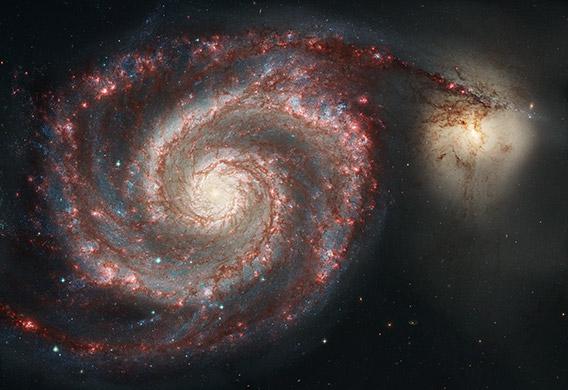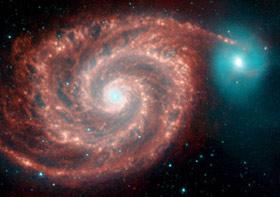For a while, on the blog, I posted a picture of a gorgeous galaxy every Monday. It was mostly just coincidence, but fun to keep up for a while.
I may have to start it up again. I’m seeing so many amazingly beautiful galaxy pictures that I just have to share them. And I can’t think of a better way to start off than with one of my favorite objects in the whole sky: M51, the Whirlpool Galaxy:

Image credit: vdHoeven/NASA/JPL-Caltech/R. Kennicutt (Univ. of Arizona)/DSS
Based on observations made with the NASA/ESA Hubble Space Telescope, and obtained from the Hubble Legacy Archive, which is a collaboration between the Space Telescope Science Institute (STScI/NASA), the Space Telescope European Coordinating Facility (ST-ECF/ESA) and the Canadian Astronomy Data Centre (CADC/NRC/CSA).
It’s not too hard to see how it got its name, is it? This picture is actually a combination of two separate space telescope images: Hubble and Spitzer, combined by the wonderful astrophotograper André van der Hoeven. The full-res version is 4000 x 2700 pixels, and nothing short of magnificent. The Hubble shot was taken in 2005, and has a total exposure time of an astonishing nine hours. It was taken in visible light, the kind we see, using filters that accentuate starlight and the gas clouds dotting the spiral arms.

Image credti: NASA/JPL-Caltech/R. Kennicutt (Univ. of Arizona)
The Spitzer image (inset here) is in the infrared, well outside what the human eye can see. The picture uses false color, meaning near-infrared shorter wavelength light is colored blue and green, and longer wavelengths are depicted as red. Because of that, dust—complex molecules that absorb visible light but glow warmly at long infrared wavelengths—looks red in the picture. In the original Hubble picture, the dust is dark, seen as brownish-black cottony structures that wind along with the spiral arms. Stars give off shorter-wavelength light in infrared, so they appear colored blue-green in the Spitzer image.
M51 is actually two galaxies (formally NGC 5194 and 5195), lying about 25 million light years away. The line-up between them is no coincidence: They are physically interacting, going through a complicated collision process. The companion, as it’s called, is a blobby collection of a few billion stars, far smaller than the spiral galaxy, which has well over a hundred billion stars. The companion’s red color in visible light means it hasn’t formed stars in a long time—blue stars are hot and massive, living their entire lives in just a few million years. When they’re gone, only redder stars are around.
The spiral, though, is quite blue, meaning it’s vigorously forming stars. The pink clumps are star-forming gas clouds, and M51 is loaded with them (note how the dust follows closely; it’s created in part where stars are born). In fact, the spiral structure is particularly strong in the galaxy, more so than usual in spirals galaxies. It’s thought that the companion collided with and passed through the disk of the spiral galaxy, disrupting it gravitationally and exciting all that star formation, which would strengthen the spiral structure as well.
This collision is not yet over. The first pass happened roughly a half billion years ago, but the gravity of the bigger galaxy held it in thrall. It came from behind, passed toward us through the disk, then swung back down and slammed through it again. Now we see it behind the bigger galaxy, as you can tell from the silhouette of the spiral’s dusty arm in front of the companion. My guess is they will eventually merge into one galaxy, but not for many millions of years.
It amazes me how much we can tell by simply looking at objects. Combining images like this helps a lot as well, since it accentuates different structures and makes it easier for our eyes to pick see them. We now have a pretty good picture of how galaxies form, how they change over time, what happens when they collide, how they behave during and after they merge. And all this unfolds over timescales of billions of years, sometimes longer than even the age of the Earth itself. When we look out into space we look back in time to all different eras of the past, and, like the pictures we take, those can be combined into a more complete picture of our Universe.